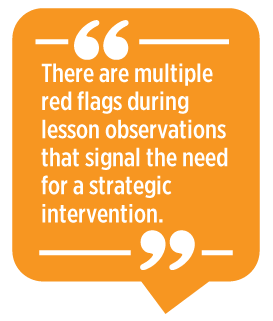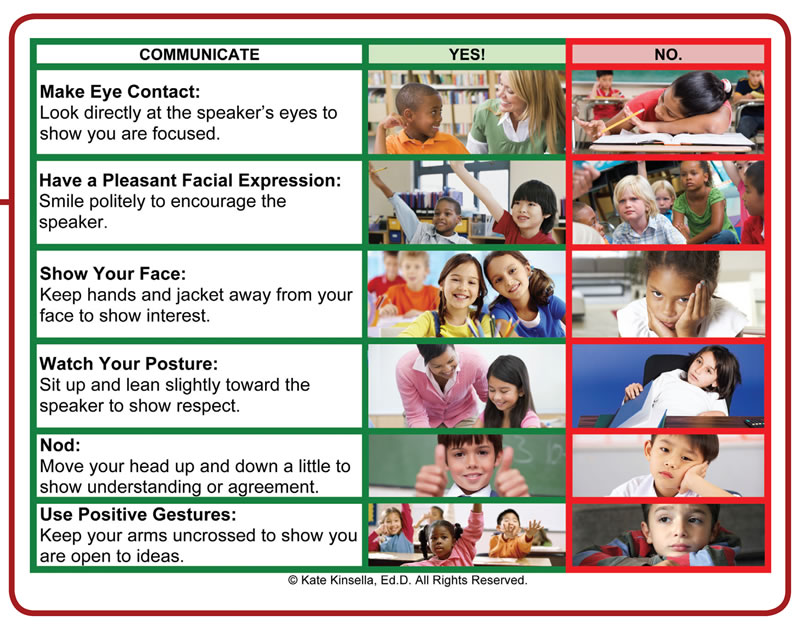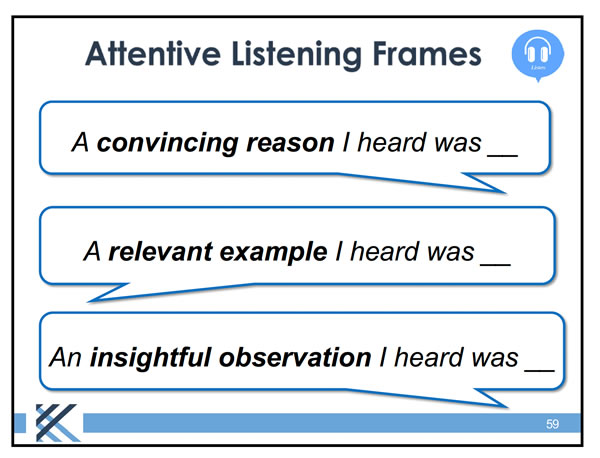|

College and career readiness initiatives within the United
States aim to prepare K–12 learners for increasingly complex life, learning,
and work environments. Across the school day, young scholars are expected to
experience lessons integrating meaningful task-based interactions. The anchor
speaking and listening Common Core State Standard for upper elementary and
secondary coursework details expectations for productive lesson discussion and
collaboration: SL1 “Engage effectively in a range of collaborative discussions
(one-on-one, in groups, and teacher-led) with diverse partners on grade (3-12)
topics and texts, building on others’ ideas and expressing their own clearly”
(CCSS, 2010). The standards architects clearly envisioned young scholars
dynamically interacting with peers, thoughtfully voicing their perspectives on
lesson content, and authentically listening. Though interdisciplinary educators
readily assign problem-solving and complex literacy tasks to peer working
groups, all too often they have failed to equip multilingual learners with the
requisite expressive and interpretive skills. A consistent area of
instructional benign neglect is explicit preparation in both the verbal and
nonverbal expectations for attentive listening during content-based lesson
interactions (Kinsella, 2016).
 Students
approaching core content in a language they are striving to master embark upon
standards-aligned lesson interactions with pronounced listening challenges.
Rubin (1995) points out that listening during lesson exchanges poses inordinate
processing demands on second language learners because they “must store
information in short-term memory at the same time as they are working to
understand the information” (p. 8). In other words, the challenge of
interpreting a teacher’s discussion prompt and expectations for a partner
interaction or the assigned classmate’s perspective lies in the necessity to
process input immediately and accurately, unlike in reading, where there is an
opportunity to reread and digest the message. Students
approaching core content in a language they are striving to master embark upon
standards-aligned lesson interactions with pronounced listening challenges.
Rubin (1995) points out that listening during lesson exchanges poses inordinate
processing demands on second language learners because they “must store
information in short-term memory at the same time as they are working to
understand the information” (p. 8). In other words, the challenge of
interpreting a teacher’s discussion prompt and expectations for a partner
interaction or the assigned classmate’s perspective lies in the necessity to
process input immediately and accurately, unlike in reading, where there is an
opportunity to reread and digest the message.
Attentive Listening Training:
When Is It Needed?
Effective
communication during a collaborative process requires more than a relevant
lesson prompt, an affable elbow partner, and a conducive seating arrangement.
As an instructional coach, I have observed multiple red flags during lesson
observations that signal the need for a strategic intervention.
Predictable
indicators that a class has not received practical training for the attentive
listening demands of academic interaction include students who are displaying
one or more of the following behaviors:
-
not maintaining eye contact or
nodding to demonstrate active engagement;
-
speaking quickly and
softly, prohibiting their partner’s accurate auditory processing;
-
failing to ask clarifying
questions when they have missed a portion of a partner’s response or don’t
understand;
-
offering ideas that have
already been contributed without recognition; and
-
not providing affirming
feedback when lesson partners suggest an approach or provide relevant content.
Introducing Physical Features
of Attentive Listening
To
effectively implement interactive lesson tasks with multilingual learners, it’s
important to provide initial instruction in the physical features of attentive
listening in U.S. classroom settings. Norms and expectations for body language
during face-to-face exchanges can differ subtly or strikingly across cultures
and communities. Within workplace and academic settings in the United States,
for example, there are fairly consistent expectations that individuals
establish and maintain eye contact while conversing, whether with peers or
superiors, to demonstrate engaged listening and a modicum of respect. However,
development of this critical “soft skill” is often overlooked in teacher
preparation to work with students from diverse cultural and linguistic
backgrounds. We shouldn’t rely upon our students’ ability to function as
armchair anthropologists, skillfully noting communication protocol distinctions
between their prior schooling and current setting.
In my
experiences supporting multilingual learner communicative competence in K–12
and higher education, eye contact has proven to be the most nuanced and
sensitive component of nonverbal communication. I advise preparing thoughtful
notes to draw from when introducing this variable rather than improvising and
running the risk of further confusing students about protocols for face-to-face
interactions. I offer the following commentary for my students as a starting
point for discussion.
Sample Notes for
Introducing the Importance
of Eye Contact
In
the United States, looking at someone’s eyes as you speak shows respect and
active listening. It is so important in North American society that there is an
expression “to make eye contact,” just like two magnets making contact and not
coming apart. Looking away may tell the speaker that you are not interested,
distracted, nervous, or unprepared.
This isn’t universal. In
some communities and cultures, eye contact may not be so necessary or have
different rules for showing respect, such as a child not looking directly at an
elder’s eyes while speaking. Adjust your behavior and respectfully follow what
you know to be appropriate at home and in your community. But at school and
work, it is an expectation that you look directly at a person’s eyes when they
are communicating important information to you. It is also vital when you speak
to people who are helping you in official places, like a doctor’s office, a
bank, or a police station.
Preparing Visual
References for Nonverbal Features
Taking into
consideration the class’s age range and context for schooling, it is useful to
prepare a visual reference to graphically illustrate physical attributes of
attentive listening. For example, the poster shown in Figure 1 was designed for
elementary learners in a dual language program as part of a professional
development initiative to increase the quality and quantity of academic
interactions taking place across the school day. Students become more mindful
of their body language during class discussions, whether teacher-led or with
peers, when complemented by
-
nonjudgmental explanation,
-
modeling,
-
orchestrated practice, and
-
respectful reminders.
Conscientious attention to how they
are presenting themselves physically during interactions serves English
learners well as they navigate the school day communicating with different
teachers, instructional aids, classmates, counselors, and
administrators.

Figure 1. Demonstrating attentive listening:
nonverbal communication. (Click here to enlarge.)
Building Productive Verbal
Skills for Attentive Listening: Discussion and Collaboration
Classroom
academic interactions include two major task types: discussion and collaboration. Many educators use the terms conversation, discussion, and collaboration interchangeably. If an English learner
transitions from foundational coursework in a newcomer support context having
only been instructed to “think-pair-share,” it can come as quite a surprise
when core content-area teachers incorporate rigorous lesson tasks with
expectations for mature discussion or collaboration.
Types of Academic
Interactions
-
Discussion: exchanging ideas on an assigned topic with a lesson partner, group, or class,
drawing from text evidence, lesson content, background knowledge, or prior
experience
-
Collaboration: working together with a lesson partner or group on an assigned task to create a
mutually agreed upon and jointly constructed response, solution, or project
Both
academic interaction types necessitate more accountable listening than casual
sharing. To lighten the cognitive load for English learners, educators across
subject areas should strive for lexical precision when assigning lesson
interactions and specify whether it is a brief informal conversation using
everyday English, an academic discussion, or a collaborative endeavor. In this
way, novice English speakers will at least approach the task with a clearer
idea of the interaction process and intended outcome.
Addressing Language Functions
for
Discussion and Collaboration
To engage
appropriately in a lesson interaction and demonstrate attentive listening, all
students benefit from planned, intentional instruction in expressions to
accomplish a range of communicative purposes or functions (Dutro &
Kinsella, 2010). Academic discussion and collaboration involve several
overlapping language functions, but collaboration requires an additional
linguistic skill set. Both entail expressive uses of language, such as stating
and supporting opinions with evidence drawn from text sources, background
information, or experience. Productive discussion and collaboration focused on
academic content similarly hinge on recognizing others’ responses by agreeing,
comparing, or building upon what has been stated.
Additionally, within a mature
discussion or task-based collaboration, effective partners seek clarification
when a contribution isn’t entirely clear and restate to ensure they have a firm
grasp on intended meaning. Successful collaboration begins with equitable
discussion, gleaned either through a roundtable exchange or elicitation of
ideas by a proactive team member. However, the stakes for comprehension are
much higher with a collective response than with a simple exchange of ideas.
True collaboration on an assignment requires additional language skills for
providing feedback, making suggestions, and negotiating before jointly
completing the task and reporting on behalf of the team.
Sample Language
Functions and Expressions
for Discussion and
Collaboration
|
Compare Ideas
- My idea is a lot like (Name’s).
- My (opinion, reaction) echoes (Name’s).
- My response is similar to (Name’s).
- My (response, experience) is comparable.
- (Name) and I have similar understandings.
|
Agree With Ideas
- I agree with (Name) that ________.
- I completely agree with (Name’s) idea.
- I share your perspective.
- I see your point.
- A point
well taken.
|
|
Restate Ideas
- So, you think that ________.
- So, your (idea, opinion, example) is that ________.
- So, you’re suggesting that ________.
- Yes, that’s (right, correct).
- No, not
exactly. What I (said, meant) was
________.
|
Build Upon Ideas
- My idea
builds upon (Name’s).
- I appreciate (Name’s) perspective, and I would add that ________.
- That is a point well taken; however, I would point out that ________.
|
Sample Language Functions and
Expressions
for Collaboration
|
Contribute Ideas
- We could
(say, put, write) ________.
- What should we (say, put, write)________?
- I think ________ makes the most sense.
- I think ________ would work well.
- I think we should (add, include, consider) ________.
|
Affirm Ideas
- That makes sense.
- I see what you are saying.
- That’s a great (idea, suggestion, solution).
- That would work.
- I completely understand.
|
|
Clarify Ideas
- I don’t quite understand your idea.
- I’m not certain I understand your position.
- I have a question about ________.
- What exactly do you mean by ________?
- Can you explain what you mean by ________?
|
Report a Partner/Team’s
Ideas
- My partner
(Name) pointed out that ________.
- My partner (Name) indicated that ________.
- According to (Name), ________.
- We (decided, concluded, determined) that ________.
- Our (response, reason, opinion) is that ________.
|
Preparing Directions for Lesson Interactions With
Attentive Listening Tasks
We can
support English learners in understanding the speaking and listening
expectations for planned lesson interactions by preparing clear visual
displays. In research and lesson coaching experiences, I have observed English
learners approach partner and group interactions unclear about the procedural
and linguistic expectations and needlessly struggling.
Rather than
entrust the roles, steps, and anticipated responses to their auditory
processing, prepare a set of visuals for common discussion and collaboration
tasks. Embedding direction slides in presentations works well, as does
displaying direction cards with a document camera. As students develop their
repertoire of useful expressions for common attentive listening tasks, such as
comparing and restating to verify understanding, proceed to more complex
language priorities such as paraphrasing and building upon and affirming ideas.
The slides
shown in Figure 2 were developed for a schoolwide endeavor to maximize student
verbal engagement and initiate all students, English learners and English-only
alike, to cross-disciplinary expectations for academic discussions.

Figure 2. Sample direction slides for partner
discussion and class discussion. (Click here to enlarge.)
Establish Concrete Listening Tasks for Class Discussions
Beginning
with novice English speakers in elementary and secondary contexts, I have
experienced considerable success establishing dual goals for attentive
listening in class discussions: 1) the focused listening and possible brief
note-taking task; 2) the language function(s) and key expressions.
1. Focused
Listening
Prior to
launching a unified-class discussion, concretize students’ listening task in
terms of the specific content they should focus upon and strive to record.
Merely encouraging students to “listen carefully” is not likely to reap
promising results. In addition to establishing consistent norms and expressions
for attentive listening, such as comparing and building upon previously stated
ideas, specify the content you are anticipating, whether an effective strategy
for solving a problem or a serious impact on the environment.
2. Identifying Key
Content
Having
clarified and visibly displayed class discussion expectations, as in the slide
(Figure 2), I am well poised to facilitate a brief postdiscussion partner
interaction requiring peers to identify the key content that caught their
attention. Knowing the class discussion will be followed by a partner
interaction builds in greater accountability for engaged listening.
I follow the
brief partner exchange by calling on a few students to share with the unified
class what they found most compelling, using the assigned frame, for example, An effective strategy I heard was ________. This final reporting activity proves
to enhance student interest while creating another vehicle for affirming
students’ unique contributions and respectful listening.
I recommend
preparing a suite of response frames such as those shown in Figure 3, each
incorporating a different type of listening goal for discussion prompts within
your curricula. Consider drawing from these common targets for tasks within
language and literacy instruction:
-
a
strong argument
-
a
well-justified position
-
a
thoughtful analysis
-
a
creative interpretation
-
a
relevant example
-
a
possible reason
-
a
major cause
-
a
serious effect
-
a
unique perspective
-
an
interesting experience

Figure 3. Attentive listening frames
examples. (Click here to enlarge.)
Final Thoughts
Instituting
school-wide teaching practices for academic discussion and collaboration with
established speaking and listening expectations will increase the odds that
multilingual learners are equitably prepared to handle with aplomb the demands
of real-life listening during vital interactions in their social, academic, and
professional lives.
Additional Lesson
Resources
References
Common Core
State Standards. (2010). Applications of Common Core State Standards for
English language arts and literacy. http://www.corestandards.org
Dutro, S.,
& Kinsella. K. (2010). English language development: Issues and
implementation in grades 6-12. In Improving education for English
learners; Research-based approaches (pp.151–207). California
Department of Education.
Kinsella, K.
(March, 2016). Attentive listening: An overlooked component of academic
interaction. Language Magazine, 28–35.
Rubin, J.
(1995). Introduction. In D. J. Mendelsohn & J. Rubin (Eds.), A guide for the teaching of second language listening (pp.
7–12). Dominie Press.
Kate
Kinsella, EdD writes curriculum, conducts
K–12 research, and provides professional development addressing evidence-based
practices to advance English language and literacy skills for multilingual
learners. She is the author of research-informed curricular anchors for K–12
English learners, including English 3D, Language Launch, READ 180 ReaL Book,
and the Academic Vocabulary Toolkit. |